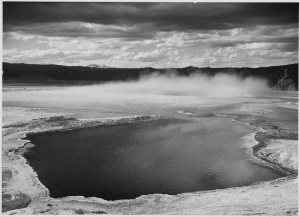Home » Posts tagged 'Caricchi'
Tag Archives: Caricchi
Supereruptions driven by magma buoyancy
Numerical modelling shows that magma buoyancy is the most important factor in determining the frequency and magnitude of the Earth’s most destructive volcanic phenomena
A new paper by a collaboration from the Universities of Geneva, Bristol and Savoie quantifies the relative contributions of magma supply, mechanical properties of the crust and magma, and tectonic regime in controlling the frequency and magnitude of volcanic eruptions. The team, led by Professor Luca Caricchi, coupled over 1.2 million simulations of a thermomechanical numerical model of magma injection into Earth’s crust with complex statistical analysis to try and replicate the behaviour of melt beneath a volcano.
This work reveals a dichotomy in the causes of volcanic eruptions, which is related to their size. It is known that small, frequent eruptions are triggered by magma replenishment, which imparts stress on the magma chamber walls; eruptions occur when this stress exceeds the strength of the surrounding rock. In contrast, Caricchi et al. demonstrate that bigger, less frequent eruptions are instead driven by the intrinsic buoyancy associated with large magma bodies, a consequence of the slow accumulation of low-density magma beneath a volcano.

Fountain Geyser Pool, Yellowstone National Park, Wyoming. Yellowstone caldera has experienced three supereruptions in the last 2.1 million years. Credit: US National Archives (79-AA-T19)
These findings are particularly important because this is the first time a physical link between the frequency and magnitude of volcanic eruptions has been established. The findings allow the predictions of the scale of the largest possible volcanic eruption on Earth; the work suggests magma chamber can contain a maximum of 35,000 km3 of eruptible magma, translating to an eruption spewing out approximately 3,500 km3 of rock. This is three times the volume released during the supereruption of Yellowstone around 640,000 years ago.
University of Bristol press release
Caricchi, L, Annen, CJ, Blundy, JD, Simpson, G & Pinel, V (2014) ‘Frequency and magnitude of volcanic eruptions controlled by magma injection and buoyancy’, Nature Geoscience. http://dx.doi.org/10.1038/ngeo2041.
SCIENTIFIC ABSTRACT
Hidden record of mafic enclaves tracks pluton assembly over time
Thermomechanical modelling of enclave deformation demonstrates that plutons grow in response to repeated injections of small pulses of magma
Plutons are large igneous bodies formed from the slow cooling of molten rock in the subsurface. Their construction reflects how magma is produced and transferred from depth, though whether this happens through sudden episodes of magma injection or small pulses of growth is a matter of active research.
Granitic plutons commonly contain mafic enclaves (fragments of less chemically evolved magma suspended in a more evolved host), produced from the intrusion and disaggregation of hotter, more mafic melts into cooler, more felsic magma. Distortion of these roughly spherical enclaves reflects the strain experienced by different areas of the pluton. The study, from Caricchi and co-authors from the University of Bristol, harnesses this record of deformation to probe the rheological, and hence thermal, evolution of a pluton during its accretion.
Caricchi et al. found that the repeated injection of magmatic pulses into a pluton resulted in expansion of the body, but that enclaves were only deformed in a two narrow temperature windows in which both the host and enclave had a similar viscosity. Knowing this, the team developed a thermomechanical model to simulate how the strain trajectories of enclaves vary as a function of time and distance from the magma injection point. Application of this model to the Lago Della Vacca Complex (LDVC), a 4.5 by 4.7 km section of the Adamello Pluton in Italy, shows that the magma body underwent radial expansion in response to multi-stage growth over 50,000- 150,000 years. Their findings are in agreement with recent geochronological estimates from zircon dating of the structure, and supply evidence for the ‘piecemeal’ nature of pluton assembly.
Caricchi, L, Annen, CJ, Rust, AC & Blundy, JD (2012) ‘Insights into the mechanisms and timescales of pluton assembly from deformation patterns of mafic enclaves’ Journal of Geophysical Research, vol 117, no. B11206. http://dx.doi.org/10.1029/2012JB009325
SCIENTIFIC ABSTRACT
